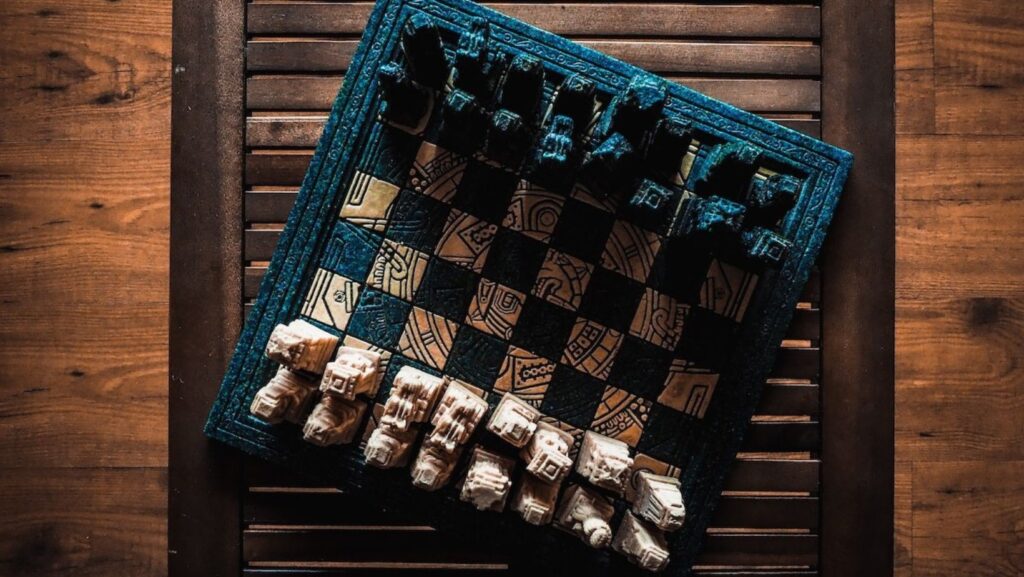
Chess is a game that has withstood the test of time. Originating over a millennium ago, its essence remains unchanged, but the materials and designs of the surfaces on which it’s played have evolved in spectacular fashion. With a renewed interest in the game, designers and craftsmen are channeling their energies into creating unique chess boards and tables. Let’s embark on a journey exploring this intriguing evolution.
1. A Nostalgic Glimpse into History
Historically, chess boards were simple. Made from wood or stone, their primary purpose was functionality. Kings, queens, knights, and pawns moved across these boards in homes, courtyards, and public spaces, reflecting the societal norms and artistic expressions of their times.
2. The Modern Metamorphosis
Today, the humble chess board has undergone a dramatic transformation. Designers are experimenting with a plethora of materials, from luxurious rosewood and elegant marble to contemporary glass and stainless steel. These boards are no longer mere gaming surfaces; they’re pieces of art. This evolution is particularly evident in the Travel Chess Set, where portability meets sophistication, offering chess enthusiasts a stylish and convenient way to enjoy their favorite game on the go.
3. Chess Tables: Beyond the Game
While a board can be portable, the chess table is often a centerpiece, representing the player’s dedication to the game. These chess tables, once simple and unadorned, now exude opulence and innovation.

Many are multifunctional, serving as both gaming hubs and stylish furniture pieces, while others have technological integrations, from touch-sensitive surfaces to electronic game recording.
4. Custom Creations: A Personal Touch
In an era of personalization, generic doesn’t cut it anymore. Enthusiasts are seeking bespoke chess boards and tables that mirror their personalities. Artisans, recognizing this trend, now offer customizations ranging from hand-painted board squares to tables carved with personal insignias or thematic elements. Some even integrate elements from beloved books or movies, turning the board into a narrative canvas.
5. A Deep Dive into Craftsmanship
The creation of a chessboard or table is no trivial task. It demands precision, creativity, and a deep understanding of materials. Woods like mahogany and oak require specific treatments to ensure longevity. Glass boards while exuding a modern charm, demand precision in crafting. Marble, with its natural veining, presents both challenges and opportunities for artisans, who can harness its patterns to enhance the board’s aesthetics.
6. Sustainability: A New Era of Design
The world is rapidly awakening to the importance of sustainable practices, and the realm of chess is no exception. Environmentally-conscious creators are leaning towards materials like bamboo, cork, or even upcycled items. Such sustainable practices not only resonate with eco-aware consumers but also introduce varied textures and patterns, adding another dimension to the game.
7. The Global Influence
Today’s chess boards and tables bear imprints from cultures around the world.

Whether it’s the intricate patterns from Indian artisans, the sleek minimalism of Scandinavian designs, or the ornate elegance of Italian craftsmanship, players can travel the world from the comfort of their gaming table.
8. For the Love of Tech
For tech aficionados, the chess world doesn’t disappoint. Some modern boards come with integrated software, allowing players to analyze their games or play against virtual opponents. Tables might feature USB ports, built-in lighting, or even connectivity options, blending tradition with the future.
9. The Fusion of Functionality and Art
While some purists might prefer the classic 8×8 grid, others are embracing boards and tables that push boundaries. These might include three-dimensional boards, abstract interpretations, or customization tables that, when not in use, transform into entirely different furniture pieces. It’s a testament to how far creativity can stretch, even within the confines of a game as ancient as chess.
10. The Future: Infinite Possibilities
As we look to the horizon, the future of chess boards and tables seems boundless. With advancements in technology, increasing global connectivity, and a renewed emphasis on craftsmanship, the next generation of chess surfaces promises to be as diverse as the game’s rich history.
Conclusion
The enduring allure of chess lies not just in its strategic depth but also in its ability to inspire, evolve, and adapt. As the designs and materials of boards and tables evolve, they mirror societal shifts, technological advancements, and artistic trends. For those immersed in the world of chess, these changes offer a chance to revel in the game’s beauty, both on and off the board.













